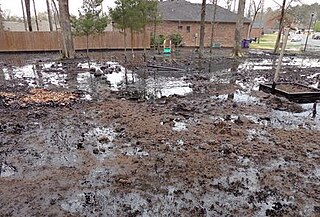
Pipeline transport is the long-distance transportation of a liquid or gas through a system of pipes—a pipeline—typically to a market area for consumption. The latest data from 2014 gives a total of slightly less than 2,175,000 miles (3,500,000 km) of pipeline in 120 countries of the world. The United States had 65%, Russia had 8%, and Canada had 3%, thus 76% of all pipeline were in these three countries.

The Kalamazoo River is a river in the U.S. state of Michigan. The river is 130 miles (210 km) long from the junction of its North and South branches to its mouth at Lake Michigan, with a total length extending to 178 miles (286 km) when one includes the South Branch. The river's watershed drains an area of approximately 2,020 square miles (5,200 km2) and drains portions of ten counties in southwest Michigan: Allegan, Barry, Eaton, Van Buren, Kalamazoo, Calhoun, Jackson, Hillsdale, Kent and Ottawa. The river has a median flow of 1,863 cubic feet per second (52.8 m3/s) at New Richmond, upstream from its mouth at Saugatuck and Douglas.
Enbridge Inc. is a multinational pipeline and energy company headquartered in Calgary, Alberta, Canada. Enbridge owns and operates pipelines throughout Canada and the United States, transporting crude oil, natural gas, and natural gas liquids. Enbridge's pipeline system is the longest in North America and the largest oil export pipeline network in the world. Its crude oil system consists of 28,661 kilometres of pipelines. Its 38,300 kilometre natural gas pipeline system connects multiple Canadian provinces, several US states, and the Gulf of Mexico. The company was formed by Imperial Oil in 1949 as the Interprovincial Pipe Line Company Limited to transport Alberta oil to refineries. Over time, it has grown through acquisition of other existing pipeline companies and the expansion of their projects. Between 2012 and 2021, Enbridge transported over 32 billion barrels of crude oil.
The Enbridge Pipeline System is an oil pipeline system which transports crude oil and dilbit from Canada to the United States. The system exceeds 5,000 kilometres (3,100 mi) in length including multiple paths. More than 3,000 kilometres (1,900 mi) of the system is in the United States while the rest is in Canada and serves the Athabasca oil sands production facilities. Main parts of the system are 2,306-kilometre-long (1,433 mi) Canadian Mainline and 3,057-kilometre-long (1,900 mi) Lakehead System. On average, it delivers 1.4 million barrels per day of crude oil and other products to the major oil refineries in the American Midwest and the Canadian province of Ontario. The Canadian portion is owned by Enbridge, while the U.S. portion is partly owned by that company through Enbridge Energy Partners, LP, formerly known as Lakehead Pipe Line Partners and Lakehead Pipe Line Company.

The Colonial Pipeline is the largest pipeline system for refined oil products in the U.S. The pipeline – consisting of three tubes – is 5,500 miles (8,850 km) long and can carry 3 million barrels of fuel per day between Texas and New York.
Plains All American Pipeline, L.P. is a master limited partnership engaged in pipeline transport, marketing, and storage of liquefied petroleum gas and petroleum in the United States and Canada. It owns interests in 18,370 miles (29,560 km) of pipelines, storage capacity for about 75 million barrels of crude oil, 28 million barrels of NGLs, 68 billion cubic feet of natural gas, and 5 natural gas processing plants. The company is headquartered in the Allen Center in Downtown Houston, Texas.

Delek US Holdings, Inc. is a diversified downstream energy company with assets in petroleum refining, logistics, asphalt, renewable fuels and convenience store retailing headquartered in Brentwood, Tennessee.
The Greenpoint oil spill is one of the largest oil spills ever recorded in the United States. Located around Newtown Creek in the Greenpoint neighborhood of Brooklyn, New York City, between 17 and 30 million US gallons of oil and petroleum products have leaked into the soil from crude oil processing facilities over a period of several decades. The spill was first noticed in 1978, and soil vapor tests were still reported as returning positive in 2008.

The Prudhoe Bay oil spill was an oil spill that was discovered on March 2, 2006 at a pipeline owned by BP Exploration, Alaska (BPXA) in western Prudhoe Bay, Alaska. Initial estimates of the five-day leak said that up to 267,000 US gallons (6,400 bbl) were spilled over 1.9 acres (7,700 m2), making it the largest oil spill on Alaska's north slope to date. Alaska's unified command ratified the volume of crude oil spilled as 212,252 US gallons (5,053.6 bbl) in March 2008. The spill originated from a 0.25-inch (0.64 cm) hole in a 34-inch (86 cm) diameter pipeline. The pipeline was decommissioned and later replaced with a 20-inch (51 cm) diameter pipeline with its own pipeline inspection gauge (pig) launch and recovery sites for easier inspection.

Greka Energy, legally HVI Cat Canyon Inc., is a privately held company engaged in hydrocarbon exploration principally in Santa Barbara County, California. Formed in 1999 after the acquisition and merger of several smaller firms, it is a subsidiary of Greka Integrated, Inc., a holding company headquartered in Santa Maria, California, and is wholly owned by Randeep Grewal.

The Kalamazoo River oil spill occurred in July 2010 when a pipeline operated by Enbridge burst and flowed into Talmadge Creek, a tributary of the Kalamazoo River near Marshall, Michigan. A 6-foot (1.8 m) break in the pipeline resulted in one of the largest inland oil spills in U.S. history. The pipeline carries diluted bitumen (dilbit), a heavy crude oil from Canada's Athabasca oil sands to the United States. Cleanup took five years. Following the spill, the volatile hydrocarbon diluents evaporated, leaving the heavier bitumen to sink in the water column. Thirty-five miles (56 km) of the Kalamazoo River were closed for clean-up until June 2012, when portions of the river were re-opened. On March 14, 2013, the Environmental Protection Agency (EPA) ordered Enbridge to return to dredge portions of the river to remove submerged oil and oil-contaminated sediment.

The 2013 Mayflower oil spill occurred on March 29, 2013, when the Pegasus Pipeline, owned by ExxonMobil and carrying Canadian Wabasca heavy crude from the Athabasca oil sands, ruptured in Mayflower, Arkansas, about 25 miles (40 km) northwest of Little Rock releasing about 3,190 barrels of oil. Approximately 3,190 barrels of oil and water mix was recovered. Twenty-two homes were evacuated. The United States Environmental Protection Agency (EPA) classified the leak as a major spill.

The Refugio oil spill on May 19, 2015, deposited 142,800 U.S. gallons of crude oil onto one of the most biologically diverse areas of the West Coast of the United States. The corroded pipeline blamed for the spill closed indefinitely, resulting in financial impacts to the county estimated as high as $74 million as it and a related pipeline remained out of service for three years. The cost of the cleanup was estimated by the company to be $96 million with overall expenses including expected legal claims and potential settlements to be around $257 million.
The Lava Cap Mine is an abandoned gold mine in Nevada County, California. The mine is located 5 miles (8.0 km) southeast of Nevada City. The site is undergoing cleanup by the United States Environmental Protection Agency for arsenic contamination.
The Keystone Pipeline oil spill occurred on December 7, 2022, when a leak in the Keystone Pipeline released 14,000 barrels of oil into a creek in Washington County, Kansas. The leak is the largest in the United States since the 2013 North Dakota pipeline spill and the largest in the history of the Keystone Pipeline.









